ICOM orporated 279521 VHF Marine Transceiver (GMDSS) User Manual IC GM1600 Instruction manual
ICOM Incorporated VHF Marine Transceiver (GMDSS) IC GM1600 Instruction manual
Contents
- 1. Users Manual
- 2. Users manual
Users Manual
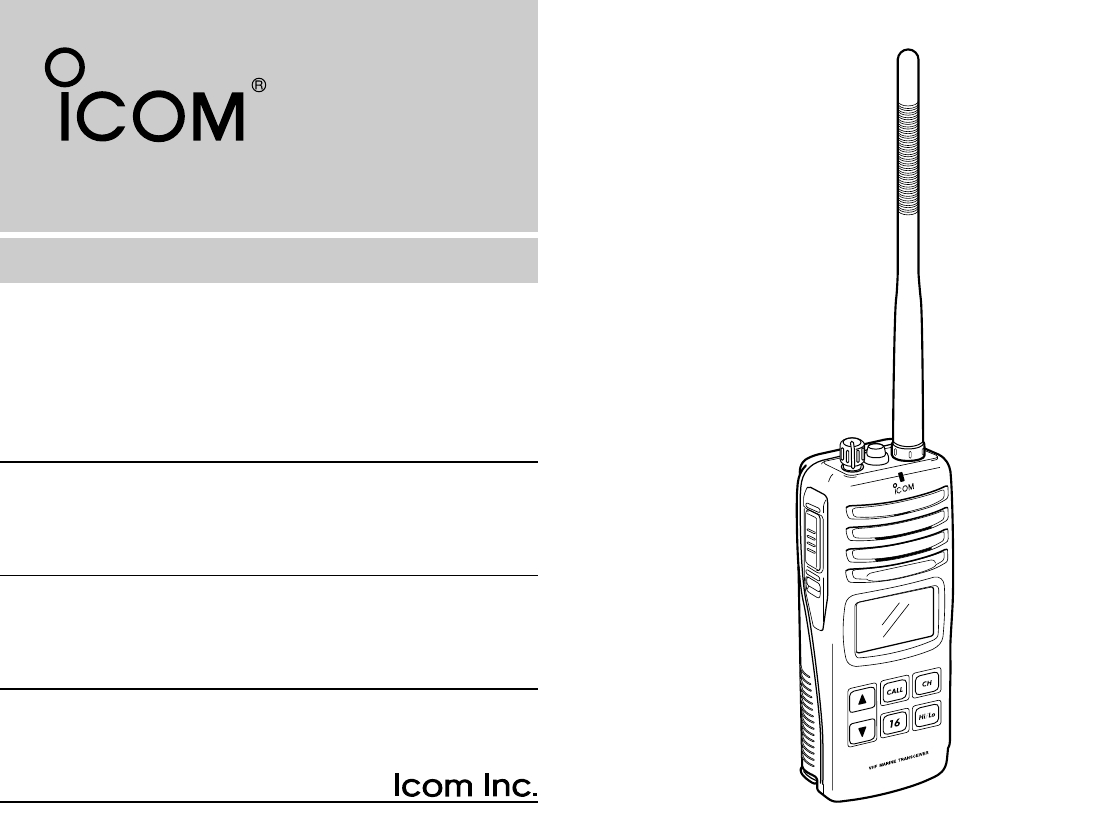
INSTRUCTION MANUAL
iGM1600
VHF MARINE TRANSCEIVER
iC-gm1600
gmdss
This device complies with Part 15 of the FCC Rules. Operation is subject
to the condition that this device does not cause harmful interference.
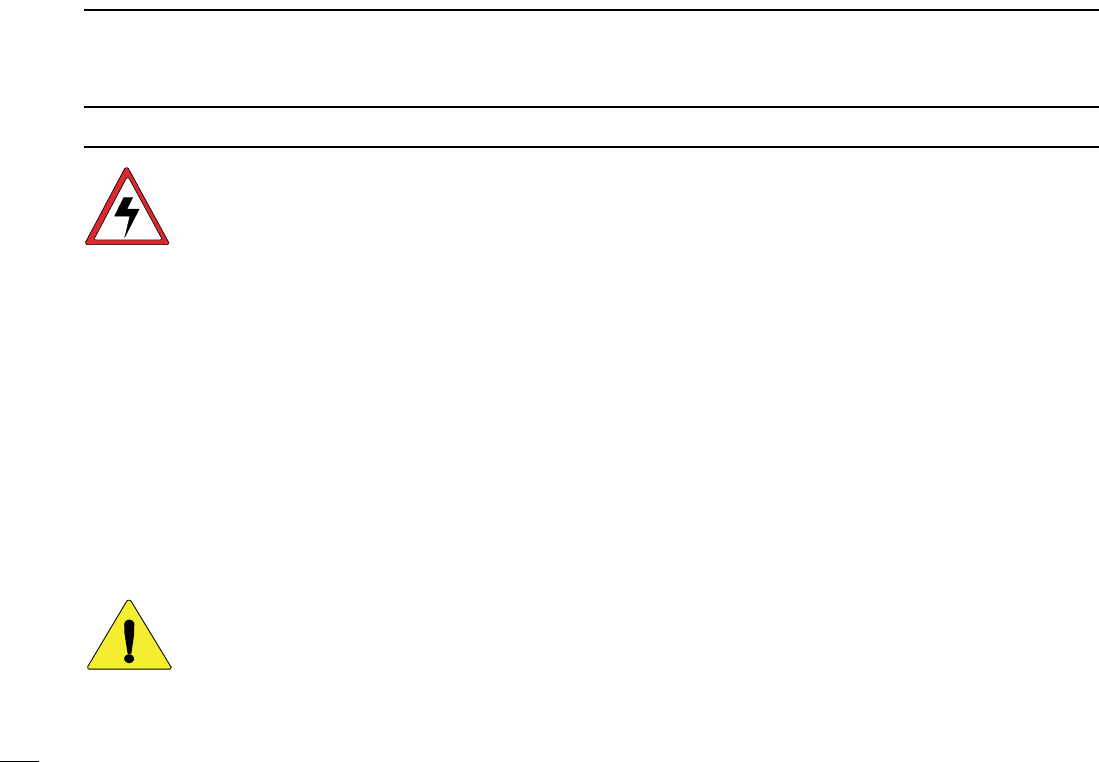
i
SAFETY TRAINING INFORMATION
Your Icom radio generates RF electromagnetic energy during
transmit mode.
This radio has been evaluated for compliance at the distance
of 2.5 cm with the FCC RF exposure limits for “Occupational
Use Only”. In addition, your Icom radio complies with the fol-
lowing Standards and Guidelines with regard to RF energy
and electromagnetic energy levels and evaluation of such lev-
els for exposure to humans:
• FCC OET Bulletin 65 Edition 97-01 Supplement C, Evaluating Compliance
with FCC Guidelines for Human Exposure to Radio Frequency Electro-
magnetic Fields.
• American National Standards Institute (C95.1-1992), IEEE Standard for
Safety Levels with Respect to Human Exposure to Radio Frequency Elec-
tromagnetic Fields, 3 kHz to 300 GHz.
• American National Standards Institute (C95.3-1992), IEEE Recommended
Practice for the Measurement of Potentially Hazardous Electromagnetic
Fields– RF and Microwave.
• The following accessories are authorized for use with this product. Use of
accessories other than those specified may result in RF exposure levels
exceeding the FCC requirements for wireless RF exposure.; Belt Clip
(MB-86, MB-103Y), Rechargeable Ni-Cd Battery Pack (BP-224) and
Lithium Battery Pack (BP-234).
To ensure that your expose to RF electromagnetic en-
ergy is within the FCC allowable limits for occupational
use, always adhere to the following guidelines:
CAUTION
WARNING
• DO NOT operate the radio without a proper antenna attached, as this may
damaged the radio and may to exceed FCC RF exposure limits. A proper
antenna is the antenna supplied with this radio by the manufacturer or an
antenna specifically authorized by the manufacturer for use with this radio.
• DO NOT transmit for more than 50% of total radio use time (“50% duty
cycle”). Transmitting more than 50% of the time can cause FCC RF expo-
sure compliance requirements to be exceeded. The radio is transmitting
when the “TX indicator” lights red. You can cause the radio to transmit by
pressing the “PTT” switch.
• ALWAYS keep the antenna at least 2.5 cm (1 inch) away from the body
when transmitting and only use the Icom belt-clips which are listed on
page 33 when attaching the radio to your belt, etc., to ensure FCC RF ex-
posure compliance requirements are not exceeded.To provide the recipi-
ents of your transmission the best sound quality, hold the radio in an
almost vertical position at least 5 cm (2 inches) from your mouth, the mi-
crophone is located next to the speaker, so you shoud “talk into the
speaker”.
The information listed above provides the user with the information needed to
make him or her aware of RF exposure, and what to do to assure that this radio
operates within FCC RF exposure limits.
Electromagnetic Interference/Compatibility
During transmissions, your Icom radio generates RF energy that can possibly
cause interference with other devices or systems. To avoid such interference,
turn off the radio in areas where signs are posted to do so. DO NOT operate
the transmitter in areas that are sensitive to electromagnetic radiation such as
hospitals, aircraft, and blasting sites.
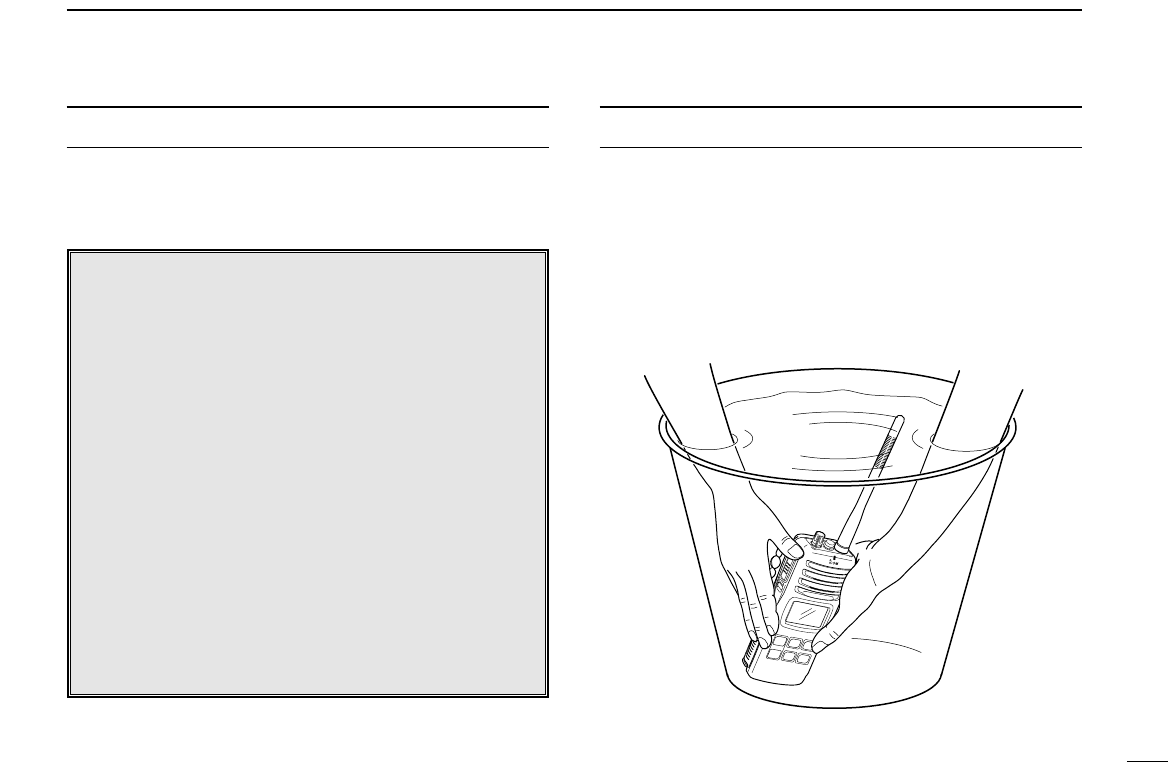
ii
IN CASE OF EMERGENCY
If your vessel requires assistance, contact other vessels and
the Coast Guard by sending a distress call on Channel 16.
❍USING CHANNEL 16
DISTRESS CALL PROCEDURE
1. “MAYDAY MAYDAY MAYDAY.”
2. “THIS IS ...........................” (name of vessel)
3. Your call sign or other indication of the ves-
sel.
4. “LOCATED AT .....................” (your position)
5. The nature of the distress and assistance re-
quired.
6. Any other information which might facilitate
the rescue.
RECOMMENDATION
CLEAN THE TRANSCEIVER THOROUGHLY WITH FRESH
WATER after exposure to saltwater, and dry it before opera-
tion. Otherwise, the transceiver’s keys, switches and con-
trollers may become inoperable due to salt crystallization.
MIC
/SP
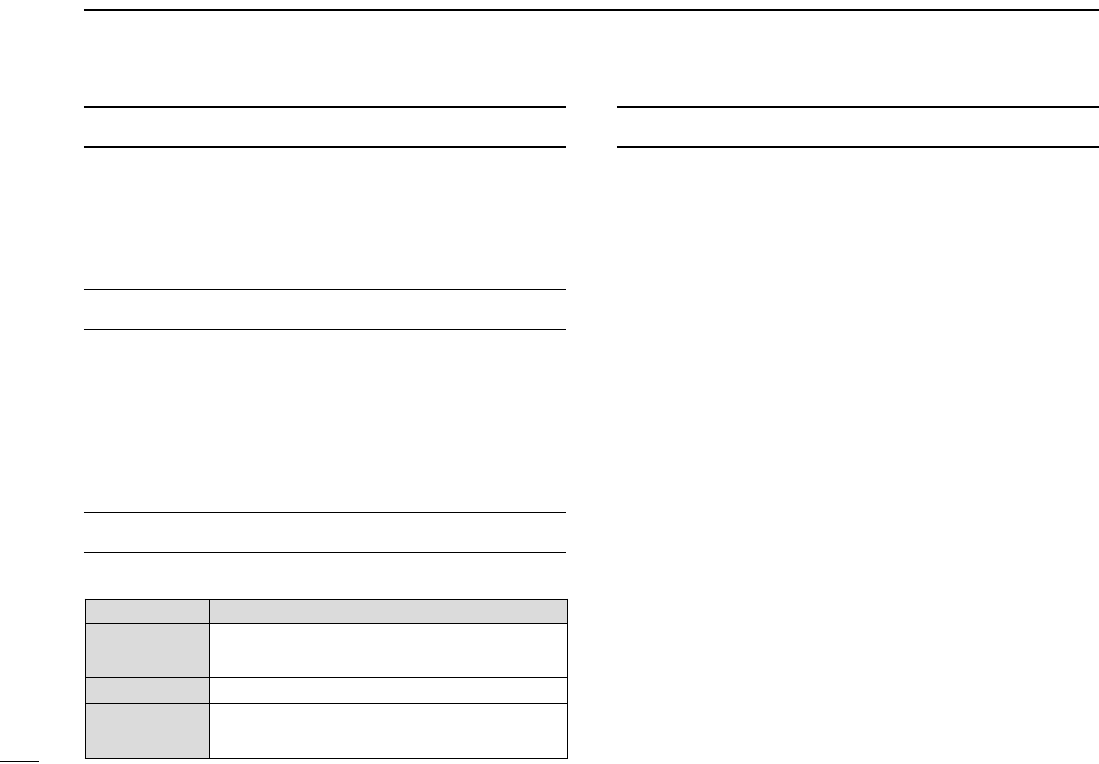
FOREWORD
Thank you for purchasing this Icom radio. The IC-GM1600 VHF
MARINE TRANSCEIVER is designed and built with Icom’s state
of the art technology and craftsmanship. With proper care this
product should provide you with years of trouble-free operation.
IMPORTANT
READ ALL INSTRUCTIONS carefully and com-
pletely before using the transceiver.
SAVE THIS INSTRUCTION MANUAL—This in-
struction manual contains important operating instructions for
the IC-GM1600.
EXPLICIT DEFINITIONS
FEATURES
☞Waterproof construction
Built tough to withstand the punishing marine environ-
ment, the IC-GM1600 meets JIS waterproof specification
grade 7 while using BP-234 (option) or BP-224.
In addition to, the speaker grill adopts a new structure
which drains water or seawater easily.
☞Large, easy-to-read LCD
With dimensions of 19(H) ×35(W) mm; 3⁄4(H) ×13⁄8(W) inch,
the IC-GM1600’s function display is easy to read and
shows operating conditions at a glance. Backlighting and
contrast can be adjusted to suit your preferences.
☞Simple operation
6 large buttons on the front panel provide user-friendly op-
eration. The independent volume and channel buttons are
located on the front panel for convenient one-handed op-
eration.
iii
WORD DEFINITION
RWARNING
CAUTION
NOTE
Personal injury, fire hazard or electric shock
may occur.
If disregarded, inconvenience only. No risk
of personal injury, fire or electric shock.
Equipment damage may occur.

iv
PRECAUTION
RWARNING! NEVER connect the transceiver to an
AC outlet. This may pose a fire hazard or result in an electric
shock.
RWARNING! NEVER hold the transceiver so that the
antenna is closer than 2.5 cm (1 inch) from exposed parts of
the body, especially the face or eyes, while transmitting. The
transceiver will perform best if the microphone is 5 to 10 cm
(2 to 4 inches) away from the lips and the transceiver is verti-
cal.
NEVER connect the transceiver to a power source other
than the BP-224 or BP-234. Such a connection will ruin the
transceiver.
AVOID using or placing the transceiver in direct sunlight or
in areas with temperatures below –20°C (–4°F) or above
+60°C (+140°F).
KEEP the transceiver out of the reach of children.
KEEP the transceiver at least 0.9 meters (3.0 ft) away from
your vessel’s magnetic navigation compass.
MAKE SURE the flexible antenna and battery pack are
securely attached to the transceiver, and that the antenna and
battery pack are dry before attachment. Exposing the inside
of the transceiver to water will result in serious damage to the
transceiver.
BE CAREFUL! The IC-GM1600 employs waterproof
construction, which corresponds to JIS waterproof specifica-
tion, Grade 7 (1 m; 3 ft depth for 30 min.). However, once the
transceiver has been dropped, waterproofing cannot be guar-
anteed due to the fact that the transceiver may be cracked,
or the waterproof seal damaged, etc.
For U.S.A. only
CAUTION: Changes or modifications to this device, not
expressly approved by Icom Inc., could void your authority to
operate this device under FCC regulations.
Icom, Icom Inc. and the logo are registered trademarks of Icom Incor-
porated (Japan) in the United States, the United Kingdom, Germany, France,
Spain, Russia and/or other countries.

1
1
OPERATING RULES
DPriorities
• Read all rules and regulations pertaining to priorities and
keep an up-to-date copy handy. Safety and distress calls
take priority over all others.
• You must monitor Channel 16 when you are not operating
on another channel.
• False or fraudulent distress calls are prohibited under law.
DPrivacy
• Information overheard but not intended for you cannot law-
fully be used in any way.
• Indecent or profane language is prohibited.
DRadio licenses
(1) SHIP STATION LICENSE
When your craft is equipped with a VHF FM transceiver, you
must have a current radio station license before using the
transceiver. It is unlawful to operate a ship station which is not
licensed.
Inquire through your dealer or the appropriate government
agency for a Ship-Radiotelephone license. This license in-
cludes the call sign which is your craft’s identification for radio
purposes.
(2) OPERATOR’S LICENSE
A restricted Radiotelephone Operator Permit is the license
most often held by small vessel radio operators when a radio
is not required for safety purposes.
The Restricted Radiotelephone Operator Permit must be
posted near the transceiver or be kept with the operator. Only
a licensed radio operator may operate a transceiver.
However, non-licensed individuals may talk over a transceiver
if a licensed operator starts, supervises, ends the call and
makes the necessary log entries.
A current copy of the applicable government rules and regu-
lations is only required to be on hand for vessels in which a
radio telephone is compulsory. However, even if you are not
required to have these on hand it is your responsibility to be
thoroughly acquainted with all pertinent rules and regulations.
1
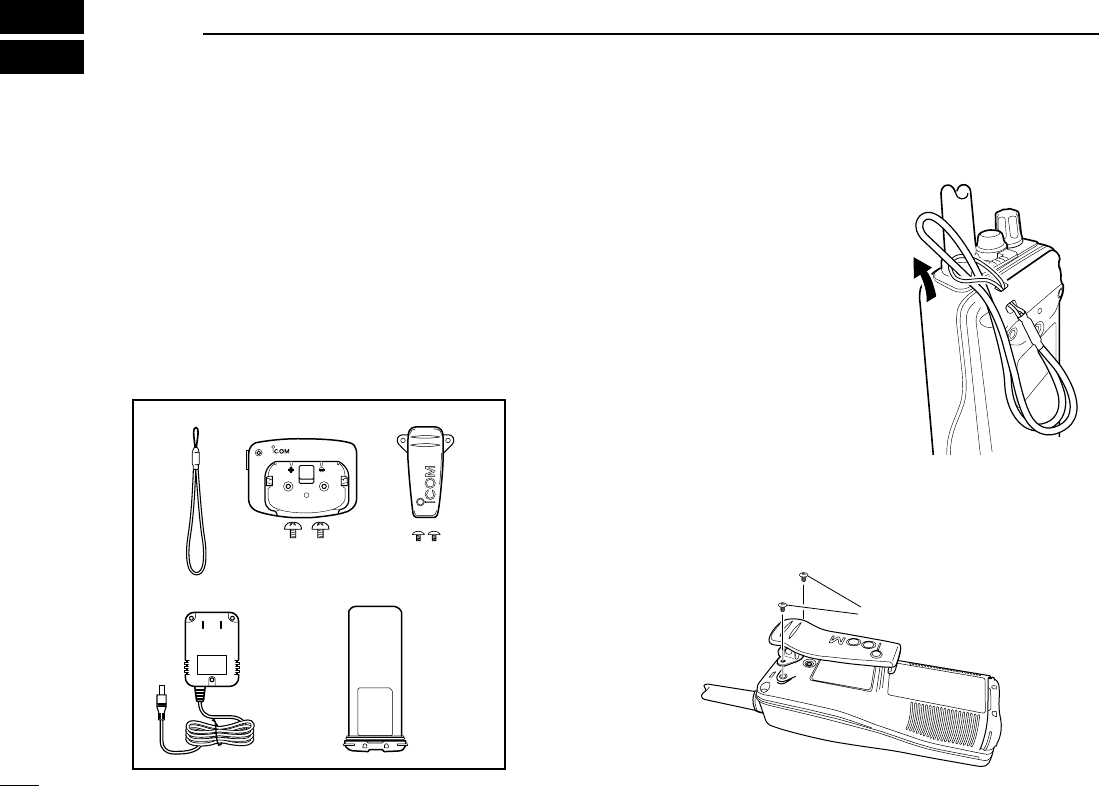
2
SUPPLIED ACCESSORIES AND ATTACHMENTS
2
■Supplied accessories
The following accessories are supplied: Qty.
qHandstrap . . . . . . . . . . . . . . . . . . . . . . . . . . . . . . . . . . . . 1
wBattery charger (BC-158) . . . . . . . . . . . . . . . . . . . . . . . . 1
eBelt clip (MB-103Y) . . . . . . . . . . . . . . . . . . . . . . . . . . . . 1
rAC adapter (BC-147A) . . . . . . . . . . . . . . . . . . . . . . . . . . 1
tNi-Cd battery pack (BP-224) . . . . . . . . . . . . . . . . . . . . . 1
■Attachments
DHandstrap
Pass the handstrap through the
loop on the top of the transceiver
as illustrated at right. Facilitates
carrying.
DBelt clip
Attach the belt clip to the transceiver as illustrated below.
Supplied screws
CHG
qw e
rt
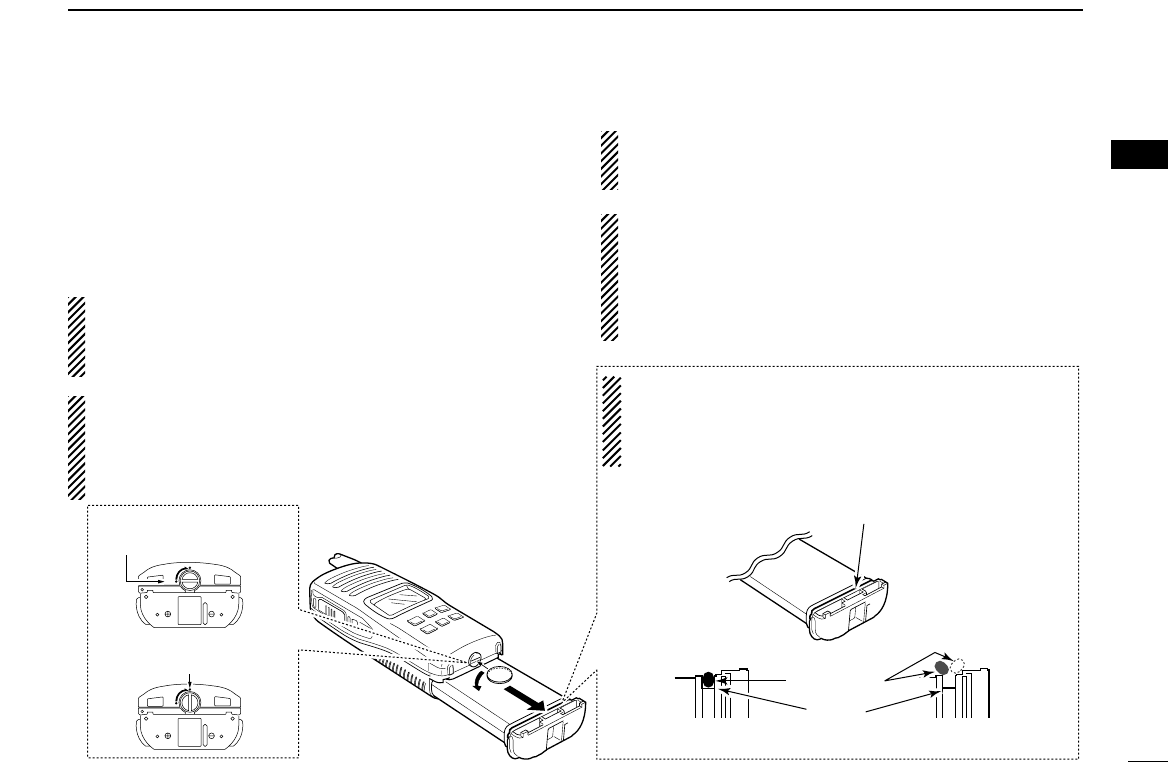
3
2
SUPPLIED ACCESSORIES AND ATTACHMENTS
ïBattery pack
To remove the battery pack:
Turn the screw counterclockwise, then pull the battery pack
in the direction of the arrow as shown below.
To attach the battery pack:
Insert the battery pack in the IC-GM1600 completely, then
turn the screw clockwise.
NEVER remove or insert the battery pack when the trans-
ceiver is wet or soiled. This may result water or dust get-
ting into the transceiver/battery pack and may result in the
transceiver being damaged.
NOTE: When removing or attaching the battery pack, use
a coin or flat-blade screwdriver to loosen or tighten the bot-
tom screw.
CAUTION!:
When attaching or removing a battery pack, make sure the
rubber seal is set in the groove of the battery pack cor-
rectly. If the seal is not neatly in the groove it may be dam-
aged when attaching the battery pack.
If the seal is damaged, waterproofing is not guaranteed.
OPEN
LOCK
Screw position
when removing battery
Screw position
when attaching battery
OPEN
LOCK
Make sure both the rubber seal (purple) is set to the groove
correctly and dust or else does not adhere to it.
Battery pack Battery pack
Rubber seal
Groove
Correct position Incorrect position
NOTE:
When attaching a battery pack, make sure dust or else does
not adhere to the rubber seal. If dust or else is on the seal
when attaching a battery pack, the water resistant may be
reduced.
2
NOTE: When the lock screw does not easily (feels tight),
check to ensure the battery pack is sufficiently inserted to
the transceiver. DO NOT bang or cause high impact to
the battery pack, as this may damage the battery pack/or
the transceiver.
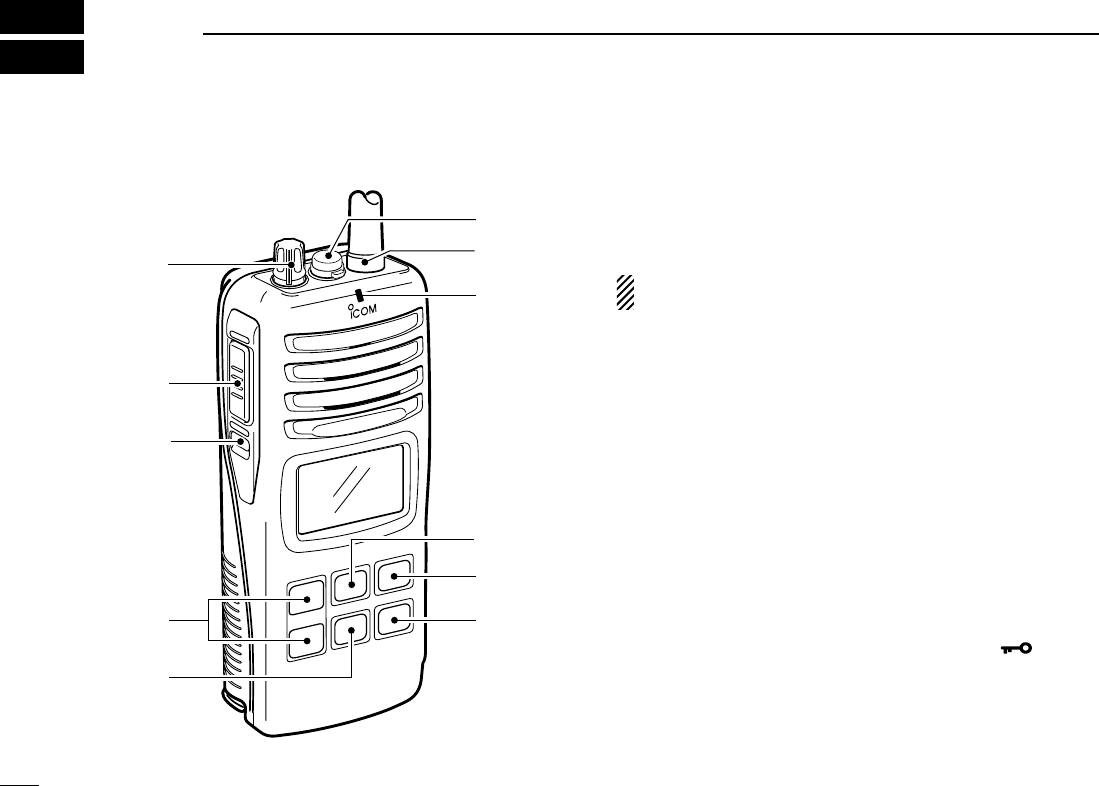
4
PANEL DESCRIPTION
3
■Front, top and side panels
qVOLUME CONTROL [VOL]
Turns power ON and adjusts the audio level.
wMICROPHONE CONNECTOR [SP MIC]
Connects the optional external microphone.
NOTE: Attach the [SP MIC] cap when the optional
speaker-microphone is not used.
eANTENNA
rTRANSMIT/RECEIVE INDICATOR
Lights green while receiving a signal or when the squelch
is open; lights red while transmitting (lights orange while
VOX function is used).
tCALL CHANNEL SWITCH [CALL]
➥Selects the call channel when pushed. (p. 7)
- Channel 9 is factory default.
➥Push for 3 sec. to enter call channel programming con-
dition. (p. 9)
yCHANNEL SWITCH [CH]
Push to return the previous conditon when priolity channel
or call channel is selected. (p. 7)
uTRANSMIT POWER/LOCK SWITCH [Hi/Lo•]
➥Selects high or low power when pushed. (p. 8)
➥Toggles the lock function ON/OFF when pushed for
1 sec. (p. 10)
MIC
/SP
o
q
!1
!0
i
y
t
u
e
r
w
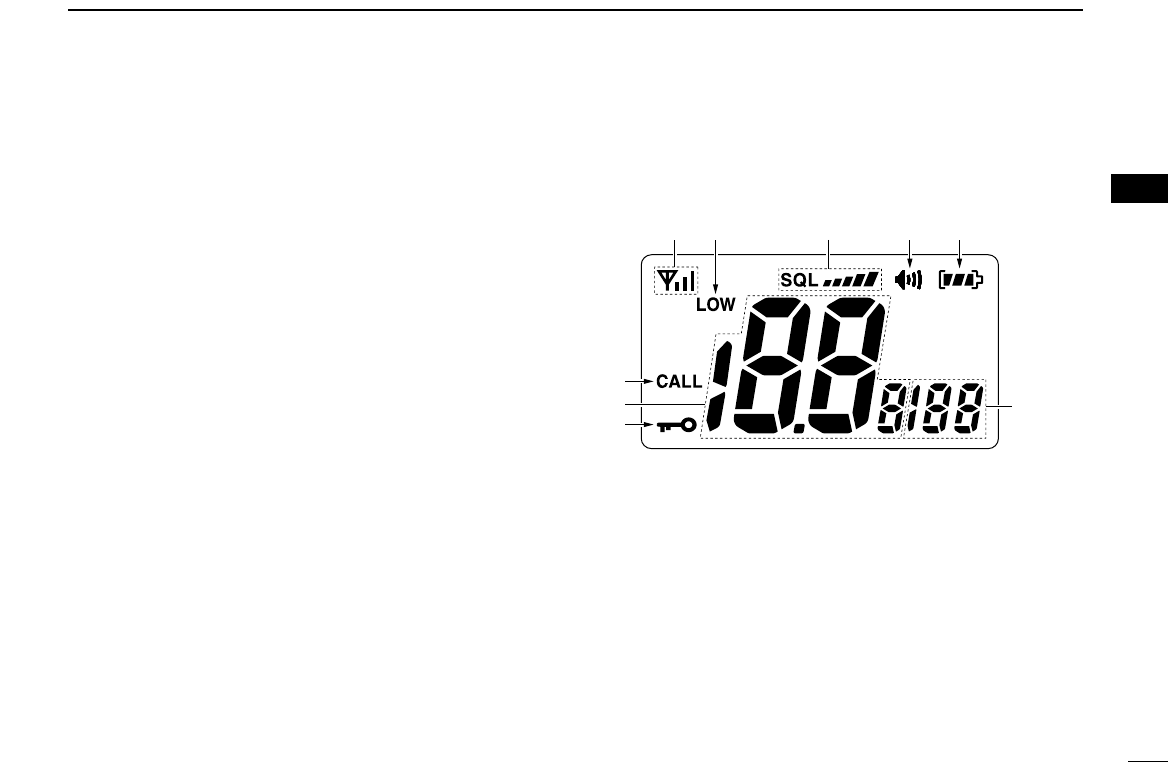
5
3
PANEL DESCRIPTION
iCHANNEL 16 SWITCH [16]
Selects Channel 16 when pushed. (p. 7)
oCHANNEL UP/DOWN SWITCHES [YY]/[ZZ]
➥Selects an operating channel. (pgs. 7–8)
➥Selects the SET mode condition of the item. (p. 11)
➥Selects the SET mode item when pushed with [SQL].
switch (p. 11)
!0 SQUELCH SWITCH [SQL•MONI]
➥Push this switch, then adjust the squelch level with
[YY]/[ZZ]. (p. 9)
➥Manually opens the squelch for monitoring the channel
while pushed and held. (p. 10)
➥While pushing this switch, turn power ON to enter the
set mode. (p. 11)
!1 PTT SWITCH [PTT]
Push and hold to transmit; release to receive.
■Function display
qSIGNAL STRENGTH INDICATOR (pgs. 10, 14)
Shows the relative signal strength while receiving signals.
wTRANSMIT POWER INDICATOR (p. 8)
➥“LOW” appears when low power is selected.
➥No indication appears when high power is selected.
eSQUELCH LEVEL INDICATOR (p. 9)
Show the squelch level.
rMONITOR INDICATOR (p. 10)
Appears when the monitor function is activated.
qw r te
y
u
i
o
3
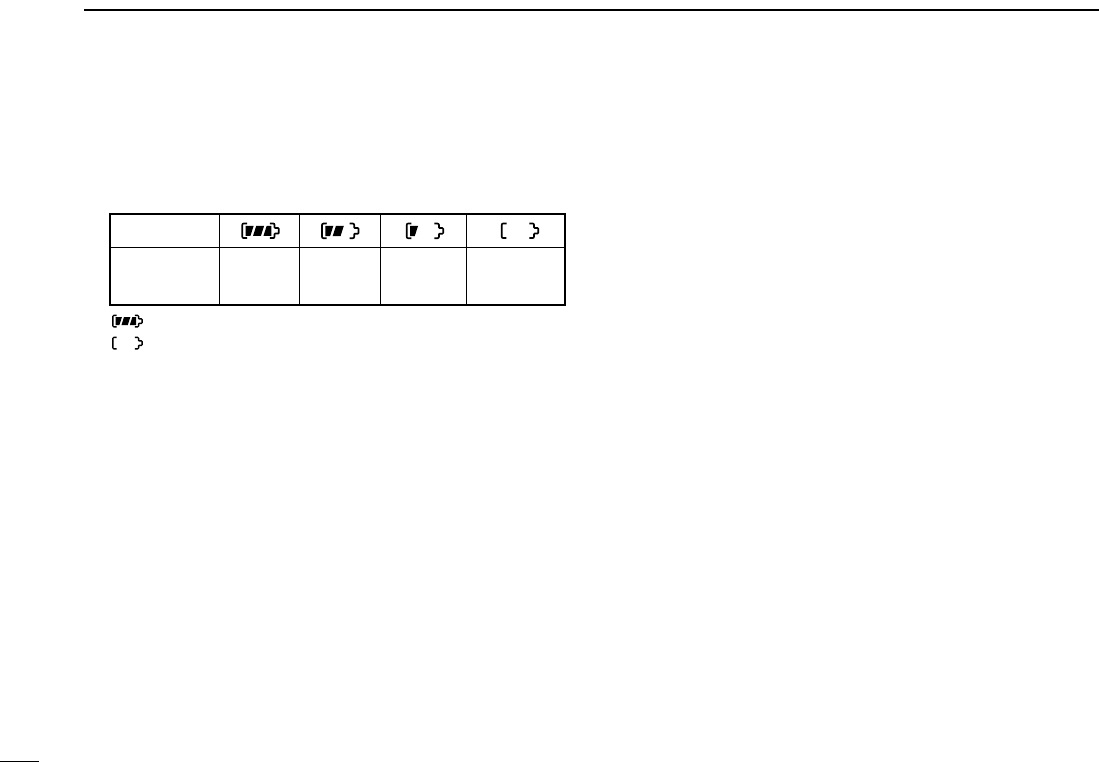
6
3PANEL DESCRIPTION
tBATTERY INDICATOR
Indicates remaining battery power.
ySET MODE ITEM READOUT
Indicates the SET mode item while in the SET mode.
(p. 11)
uLOCK INDICATOR
Appears when the lock function is activated. (p. 10)
iCHANNEL NUMBER READOUT
➥Indicates the selected operating channel number.
➥In SET mode, indicates the selected condition.
oCALL CHANNEL INDICATOR
Appears when the call channel is selected. (p. 7)
Indication
Full Middle Charging
required No battery
Battery level
blinks when the battery is exhaustion.
blinks when the battery is over charged.
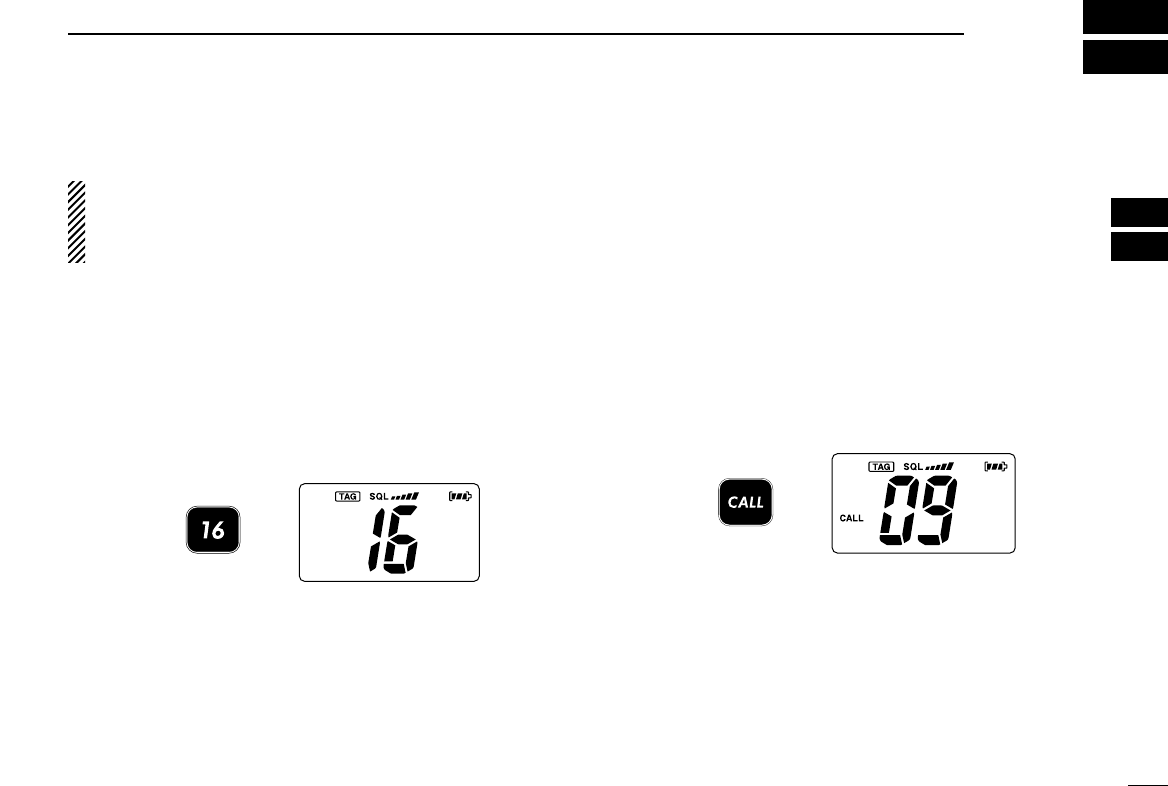
7
4
BASIC OPERATION
3
4
■Channel selection
IMPORTANT!: Prior to using the transceiver for the first
time, the battery pack must be fully charged for optimum
life and operation. To avoid damage to the transceiver, turn
the power OFF while charging.
DChannel 16
Channel 16 (Distress channel) is used for establishing initial
contact with another station and for emergency communica-
tions. While standing by, you must monitor Channel 16.
qPush [16] to select Channel 16.
wPush [CH] to return to the condition before selecting Chan-
nel 16, or push [Y]/[Z] to select the operating channel.
DChannel 9 (Call channel)
Channel 9 is the leisure-use call channel. The call channels
can be re-programmed (p. 9) and may be used to store your
most often used channels for quick recall.
qPush [CALL] to select the call channel.
•“CALL” and the call channel number appear.
•Call channel can be re-programmed. See the “Call channel
programming” on p. 9 for details.
wPush [CH] to return to the condition before selecting Chan-
nel 9 (call channel), or push [Y]/[Z] to select the operating
channel.
Push
Push
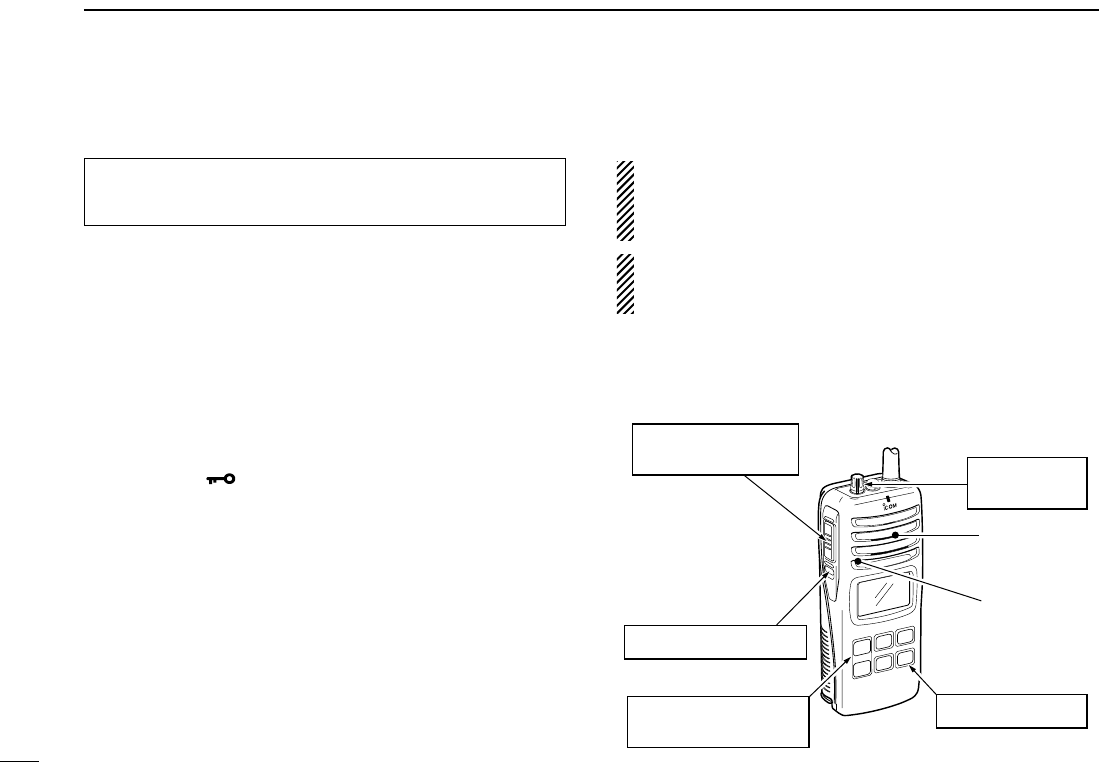
8
4BASIC OPERATION
■Receiving and transmitting
qRotate [VOL] clockwise to turn power ON.
wSet the volume and squelch level.
➥Push [SQL•MONI], and push [√] to open the squelch.
➥Push [SQL•MONI] to stop “SQL” indicator blinking, then
rotate [VOL] to set the volume level.
➥Push [SQL•MONI], and push [∫]/[√] to set the squelch
level.
ePush [Y]/[Z] to select the desired channel.
- When receiving a signal, the [TRANSMIT/RECEIVE] indicator
lights green while audio is emitted from the speaker.
- Further adjustment of [VOL] may be necessary at this point.
rPush [Hi/Lo•] to select the output power if necessary.
- “LOW” appears when low power is selected; no indication when
high power is selected.
- Choose low power to conserve battery power, choose high
power for longer distance communications.
- Some channels are for low power only.
tPush and hold [PTT] to transmit, then speak into the
microphone.
- The [TRANSMIT/RECEIVE] indicator lights red while
transmitting.
yRelease [PTT] to receive.
IMPORTANT: To maximize the readability of your trans-
mitted signal, pause a few sec. after pushing [PTT], hold
the microphone 5 to 10 cm (2 to 4 inches) from your mouth
and speak into the microphone at a normal voice level.
NOTE: The transceiver has a power save function to con-
serve the battery power. The power save function activates
automatically when no signal is received for 5 sec.
CAUTION: Transmitting without an antenna may
damage the transceiver.
MIC
/SP
q Power ON
w Set volume
r Set output power
Speaker
t Push to transmit
y Release to receive
w Set the squelch level
e Set channel
w Set the squelch level
Microphone
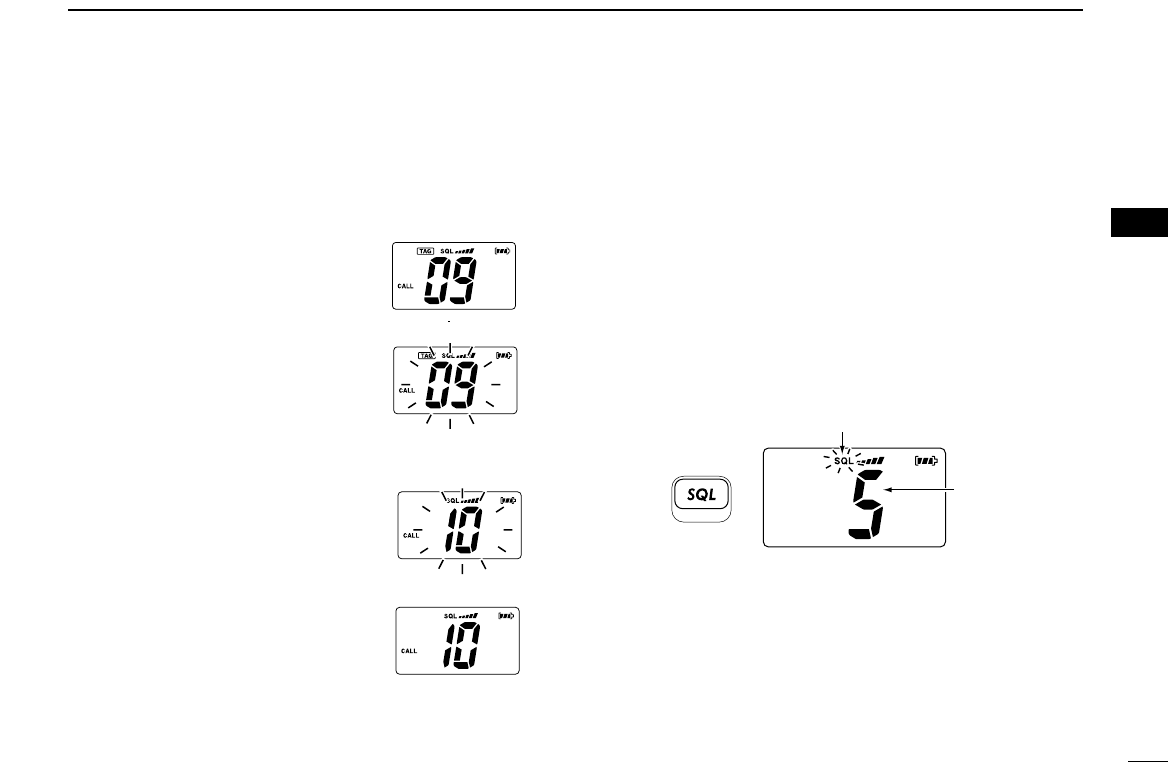
9
4
BASIC OPERATION
4
■Call channel programming
The call channel switch is used to select Channel 9 by de-
fault, however, you can program your most often-used chan-
nel for quick recall.
qPush [CALL] for 1 sec. to select the
call channel.
•“CALL” and call channel number
appear.
wPush [CALL] again for 3 sec. (until a
long beep changes to 2 short beeps)
to enter call channel programming
condition.
•Call channel number to be programmed
flashes.
ePush [Y]/[Z] to select the desired
channel.
rPush [CALL] to program the dis-
played channel as the call channel.
•The call channel number stop flashing.
■Adjusting the squelch level
To adjust the IC-GM1600’s squelch level, use the [Y]/[Z] keys
as desired below. In order to receive signals properly, as well
as for the scan to function effectively, the squelch must be ad-
justed to the proper level.
qPush [SQL•MONI], then adjust the squelch level with [Y]/[Z].
- “SQL” indicator starts blinking.
- There are 11 squelch levels to choose from: OP is completely
open; 10 is tight squelch; 1 is loose squelch level.
- When no switch is pushed for 5 sec., the transceiver returns to
normal condition.
wPush [SQL•MONI] again to return to normal condition.
Blinks during the squelch
level adjutment.
Indicates the
squelch level.
Push
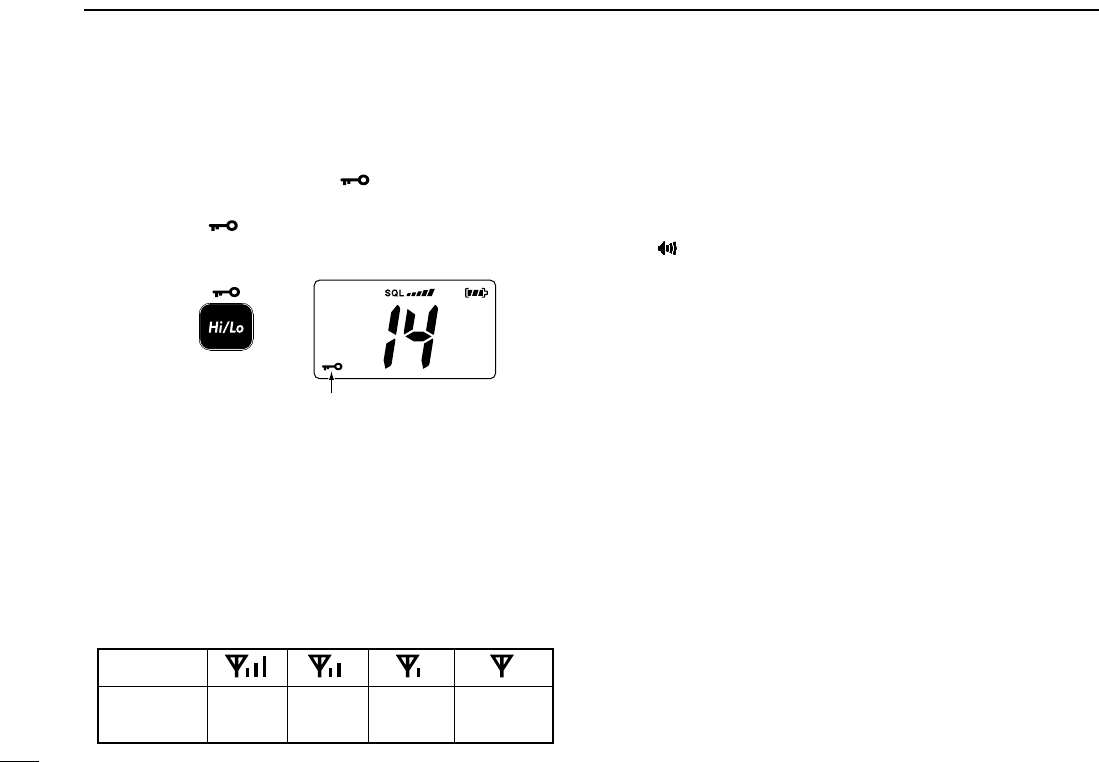
10
4BASIC OPERATION
■Lock function
This function electronically locks all switches (except for
[PTT], [SQL•MONI] and [Hi/Lo•]) to prevent accidental
channel changes and function access.
➥Push [Hi/Lo•] for 1 sec. to turn the lock function ON
and OFF.
■Signal strength indicator
function
The received signal strength level is indicated by number of
bars as below.
This indicator can be hidden by using the set mode (p. 14) if
desired.
■Monitor function
The monitor function releases the noise squelch mute to
check the volume level. See p. 12 for details of the monitor
switch action.
➥Push [SQL•MONI] for 1 sec. to activate the monitor function.
•“ ” appears and audio is emitted.
■Backlighting function
This function is convenient for nighttime operation. The back-
lighting brightness can be adjusted in the SET mode. (p. 12)
➥Push any switch except for [PTT] to turn the backlighting
ON.
•The backlighting is automatically turned OFF after 5 sec. of
inactivity.
Indication
Strong Middle Weak No signal or
very weak
Signal
strength
Appears while the
lock function is used.
Push
for 1 sec.
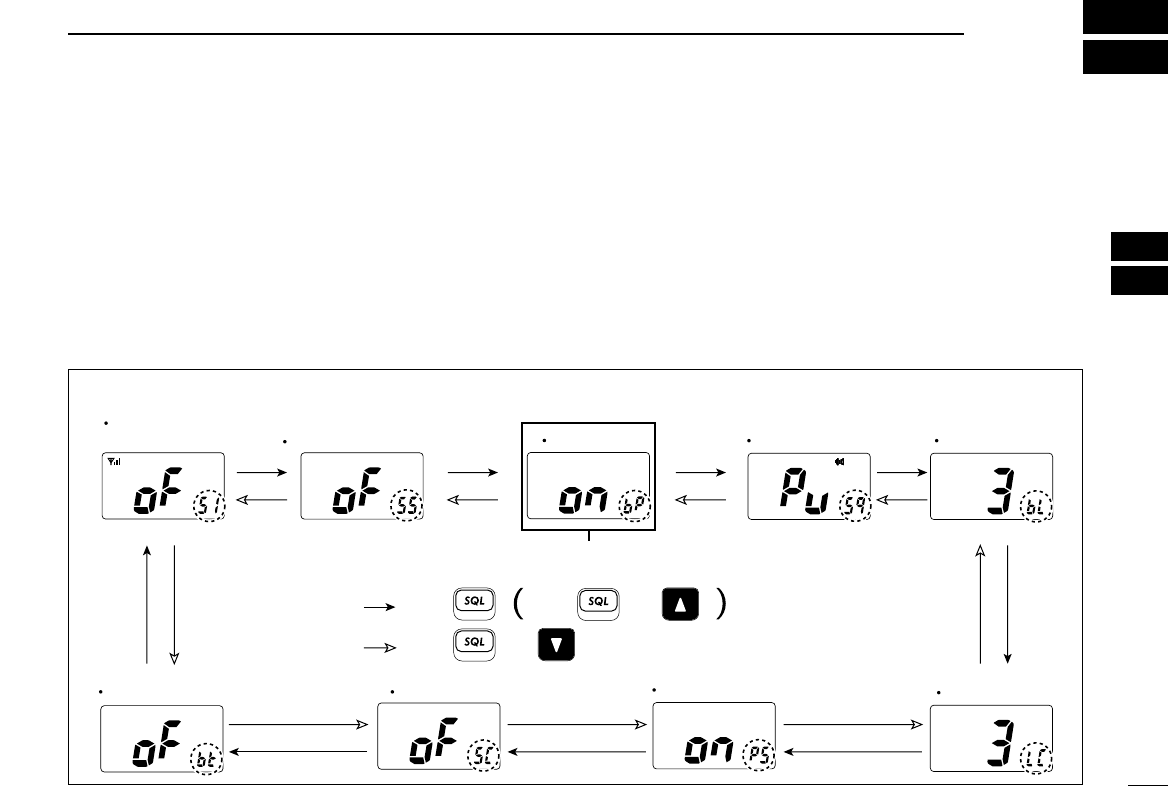
11
5
SET MODE
4
5
■SET mode programming
SET mode is used to change the condition of 9 transceiver
functions: beep tone function, monitor switch action, back-
lighting function, LCD contrast selection, auto power save
function, self check function, battery voltage indicator, signal
strength indicator and squelch sensitivity function.
DSET mode operation
qTurn power OFF.
wWhile pushing [SQL•MONI], turn power ON to enter the
SET mode.
• “bp” (Beep tone function setting) appears.
ePush [SQL•MONI] or [SQL•MONI] and [Y]/[Z] to select the
desired item, if necessary.
rPush [Y]/[Z] to select the desired condition of the item.
tTo exit the SET mode, push [16].
DSET MODE ITEMS The displays show the default settings, and the selected item is displayed in the dotted circle.
Battery voltage
Signal strength
indicator Beep tone Monitor switch Backlighting
LCD contrast
Auto power save
Self check
Squelch sensitivity
: Push
: Push and
Starting item
Push and
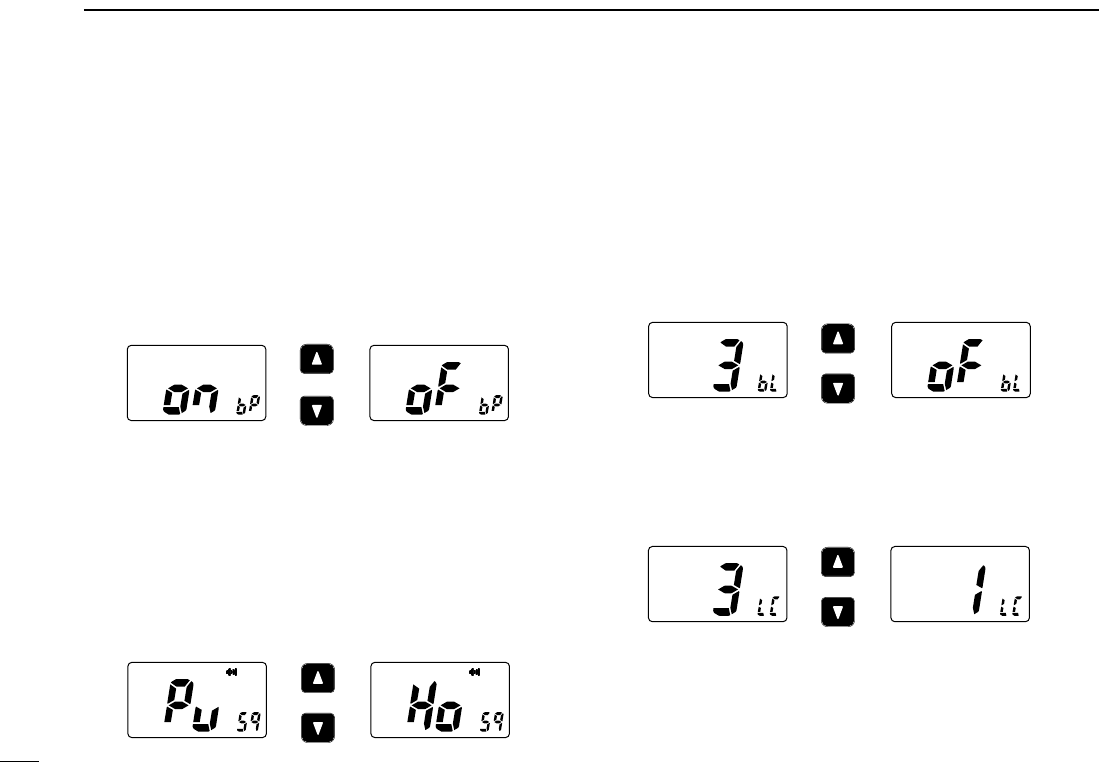
12
5SET MODE
■SET mode items
DBeep tone function “bP”
You can select silent operation by turning the beep tones
OFF, or you can have 2 types of confirmation beeps sound at
the push of a switch. When “ON” is selected, a fixed beep (Pi)
sounds, and when “US” is selected, the preset beeps (e.g.
do, re, mi) sound.
• Beep tone synchronises with the volume level.
• The beeps sound during call channel programming and a weather
alert tone indication even if this function is turned OFF.
DMonitor switch action “Sq”
The monitor switch action cuts off the squelch function tem-
porarily. This switch action contains PUSH (Pu) or HOLD (Ho)
settings as shown below.
• Pu (PUSH): After pushing [SQL•MONI] for 1 sec., the squelch opens
and emits audio. The squelch is held open while con-
tinuously pushing and holding [SQL]. (default)
• Ho (HOLD): After pushing [SQL•MONI] for 1 sec., the squelch opens
and emits audio even [SQL•MONI] is released. To close
the squelch, push any switch.
DBacklighting function “bL”
This function is convenient for nighttime operation. The back-
lighting brightness can be adjusted from OFF, 1 (dark)–3
(bright); 3 (default). Select 1–3 to turn this function ON.
•
The automatic backlighting turns the backlighting ON when any
switch except for [PTT] is pushed.
•
The backlighting is automatically turned OFF after 5 sec. of inactivity.
DLCD contrast selection “LC”
The contrast of the LCD can be adjusted from 4 levels.
•
1 (bright)–4 (dark); 3 (default)
Push
Beep tone ON (default) Beep tone OFF
Push
Push setting (default) Hold setting
Push
Backlighting ON
(default)
Backlighting OFF
Push
Middle contrast
(default)
Low contrast
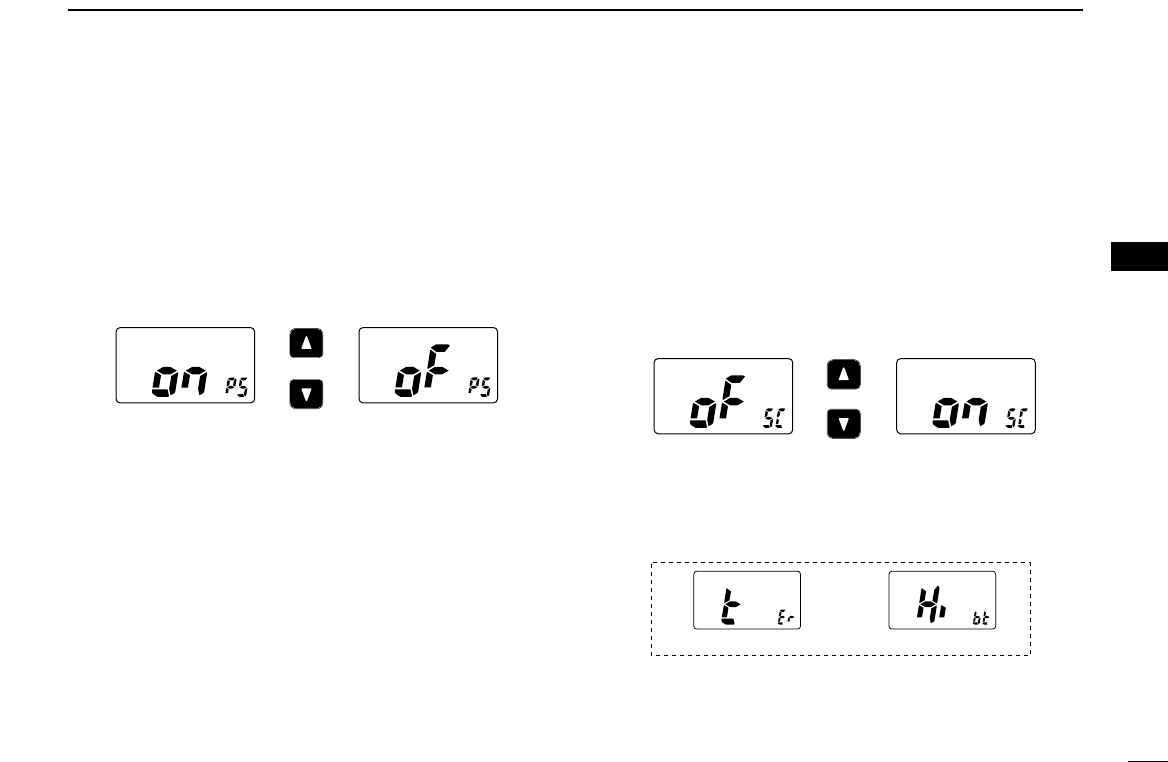
13
5
SET MODE
5
DAuto power save function “PS”
The auto power save function reduces current drain by deac-
tivating the receiver circuit for preset intervals.
• ON : The power save function is turned ON. The power save func-
tion will activate when no signal is received, and no operation
is performed for 5 sec.
• OFF: The power save function is turned OFF.
DSelf check function “SC”
The self check function checks the transceiver conditions by
itself, and informs you in case a problem is found. Self check
automatically and quickly runs through its diagnostic steps
each time the radio is turned ON. Afterwards, the radio
switches to normal operation mode.
• Temperature : Outside of –35°C to +80°C; –31°F to +173°F
(approx.)
• Connected battery voltage
When error messages as shown below are displayed, see
troubleshooting for advice. (p. 28)
Push
Power save ON
(default)
Power save OFF
Push
Self check OFF (default) Self check ON
Temperature error Battery voltage error
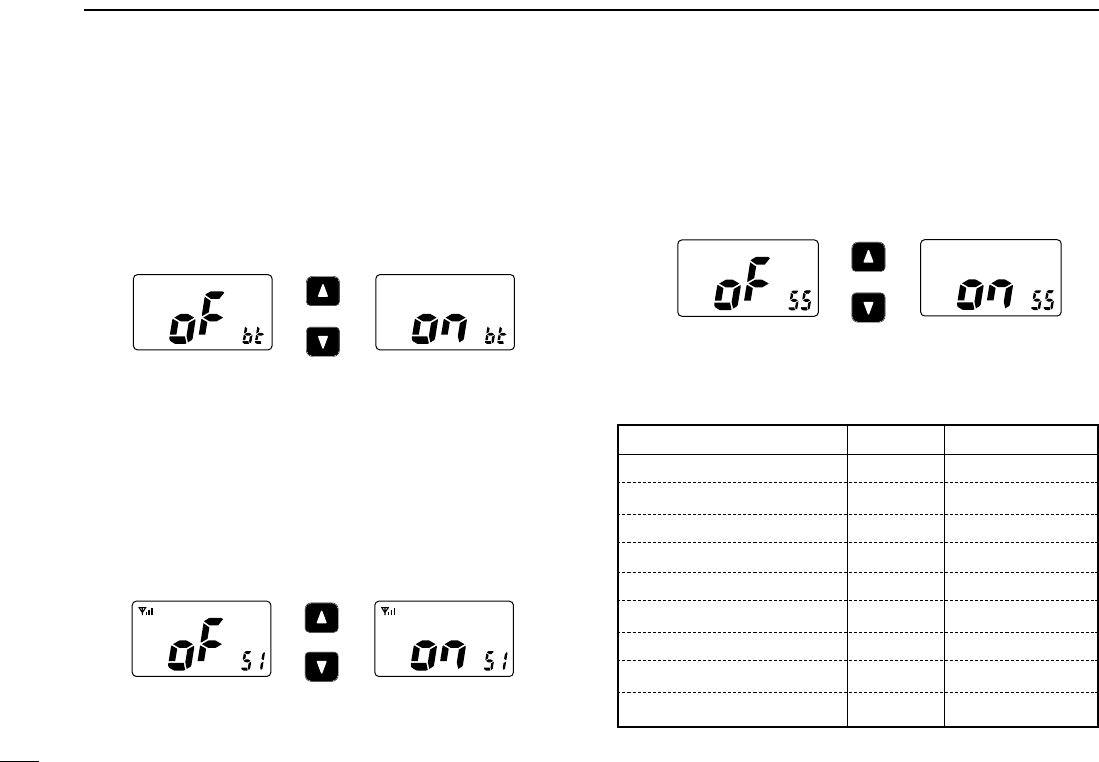
14
5SET MODE
DBattery voltage indicator “bt”
This function controls display or non-display settings of the
connected battery pack’s voltage when the power is ON.
•
The voltage of the connected battery pack is displayed for 2 sec.
after power is turned ON.
DSignal strength indicator “Sl”
The signal strength indicator displays received signal strength
as “S-meter”. This function is convenient to check the signal
strength visually.
•
The strength is displayed at 4 steps.
• The antenna mark and 3 bars appear when receiving strong signals.
• The antenna mark only appears when receiving no signal.
DSquelch sensitivity function “SS”
When this function is turned ON, blocking against noise is im-
proved. Therefore the squelch is not easily affected by noise.
SET MODE LIST
*default setting
Push
Battery voltage
indication OFF
(default)
Battery voltage
indication ON
Push
Signal strength
indication OFF
(default)
Signal strength
indication ON
Function Indication Switch
Beep tone function “bP”OFF/ON*/US
Monitor switch action “Sq”Push*/Hold
Backlighting function “bL”OFF/1/2/3*
LCD contrast selection “LC”1/2/3*/4
Auto power save function “PS”OFF/ON*
Self check function “SC”OFF*/ON
Battery voltage indicator “bt”OFF*/ON
Signal strength indicator “SI”OFF*/ON
Squelch sensitivity “SS”OFF*/ON
Push
Squelch sensitivity OFF
(default)
Squelch sensitivity ON
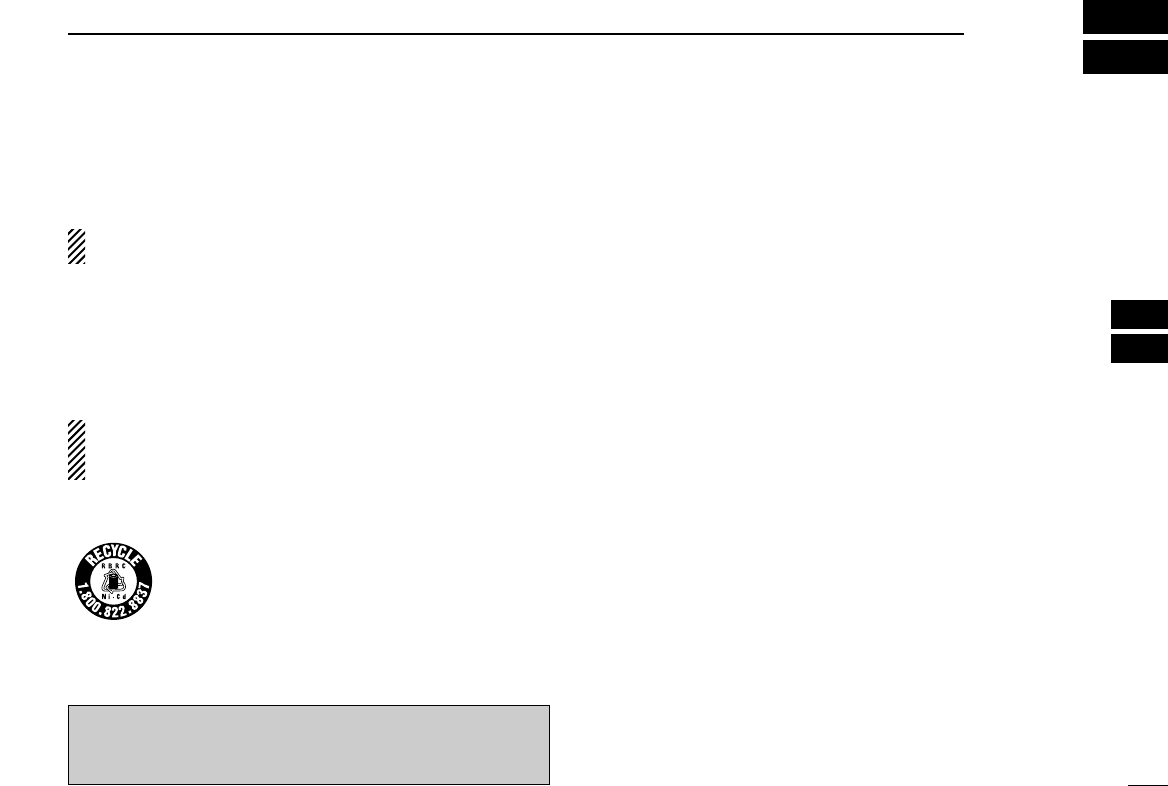
25
7
BATTERY CHARGING
6
7
■Battery charging
Prior to using the transceiver for the first time, the battery
pack must be fully charged for optimum life and operation.
CAUTION: To avoid damage to the transceiver, turn the
power OFF while charging.
• Recommended temperature range for charging:
+10°C to +40°C (+50°F to +104°F)
• Use the specified chargers (BC-158, BC-119N and
BC-121N). NEVER use another manufacture’s charger.
• Use the supplied AC adapter for the BC-158. NEVER use
another manufacture’s adapters.
NEVER connect DC power to the battery case when in-
stalling Alkaline batteries. Such a connection will damage
the transceiver.
DRecycling information
The product that you have purchased contains a
rechargeable battery. The battery is recyclable.
At the end of its life, under various state and
local laws, it may be illegal to dispose of this bat-
tery into the municipal waste stream. Call 1-800-
822-8837 for battery recycling options in your
area or contact your dealer.
■Battery cautions
CAUTION! NEVER insert battery pack/transceiver
(with the battery pack attached) with wet or soiled into the
charger. This may result in corrosion of the charger terminals
or damage to the charger. The charger is not waterproof and
water can easily get into it.
NEVER incinerate used battery packs. Internal battery gas
may cause an explosion.
NEVER immerse battery pack in water. If the battery pack
becomes wet, be sure to wipe it dry immediately (particularly
the battery terminals BEFORE attaching it to the transceiver).
NEVER short the terminals of the battery pack. Also, cur-
rent may flow into nearby metal objects, such as a necklace,
etc. Therefore, be careful when carrying in a pocket, back-
pack or handbag, and when placing the radio near metal ob-
jects.
If your battery pack seem to have no capacity even after
being charged, completely discharge it by leaving the power
ON overnight. Then, fully charge the battery pack again. If the
batteries still do not retain a charge (or very little), new bat-
tery pack must be purchased.
Turn the transceiver OFF when charging an attached bat-
tery pack. Otherwise, the battery pack may not become full-
charging or may not charge properly.
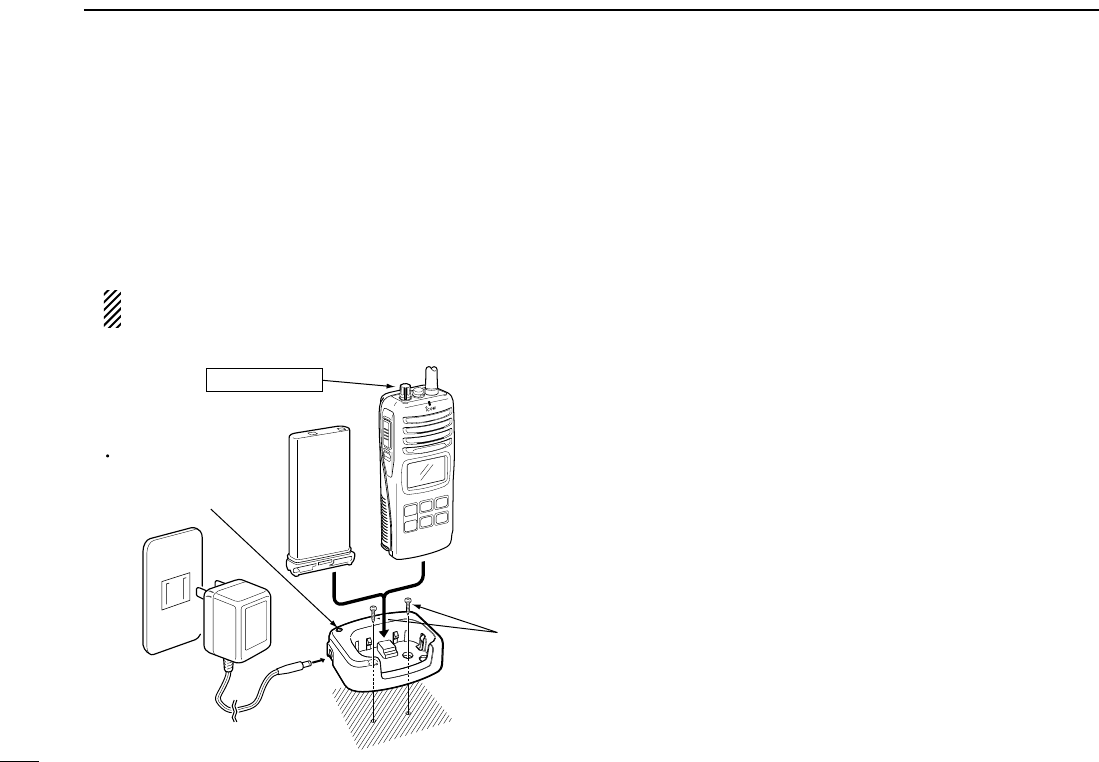
26
7BATTERY CHARGING
ïCharging connections
qAttach the BC-158 to a flat surface, such as a desk.
wConnect the AC adapter as shown below.
eInsert the battery pack with/without the transceiver into the
charger.
• The charge indicator lights green.
rCharge the battery pack approx. 8 hours, depending on
the remaining power condition.
DO NOT charge the BP-224 more than 12 hours. Oth-
erwise, the BP-224 will be damaged.
■Optional battery pack
The optional BP-234 battery pack is a non-rechargeable,
Lithium battery pack. The following precaution must be ob-
served.
• NEVER dispose of the BP-234 or battery pack in a fire. This could
result in a fire or explosion.
• DO NOT short-circuit the BP-234 or battery pack. Metal contact
(such as paper clip, another battery, etc.) across the battery con-
tacts can result in a sustained high rate discharge, which could
damage the battery, void the warranty and create a burn or a fire
hazard.
• NEVER expose of the BP-234 or battery pack to excessive heat of
60°C (+140°F) or abobe. This could result in electrolyte leakage,
possibly causing an explosion or fire.
• NEVER attempt to recharge the BP-234 or battery pack. Lithium
batteries may explode or cause a fire in such cases.
• DO NOT disassemble the BP-234 or battery pack. The BP-234 or
battery pack contains no user serviceable parts. Internal battery gas
can cause throat irritation. Alse, exposed lithium may generate heat
and ignite.
• DO NOT apply excessive pressure to the battery. This may result
in electrolyte leakage, possibly causing a explosion or fire.
• The storage life of the BP-234 about 5 years. Once the expiration
date on the battery pack expires, a new battery pack must be pur-
chased.
• For safety reasons, once the BP-234 is used, a spare one should be
purchased. The original battery pack can be continued to be used
for regular communications; save the spare one for emergency sit-
uations.
AC adapter
IC-GM1600
BP-224
BC-158
Supplied
screws
Charge indicator
Lights green when the
BP-224 (with/without
IC-GM1600) is inserted.
Turn power OFF
MIC
/SP
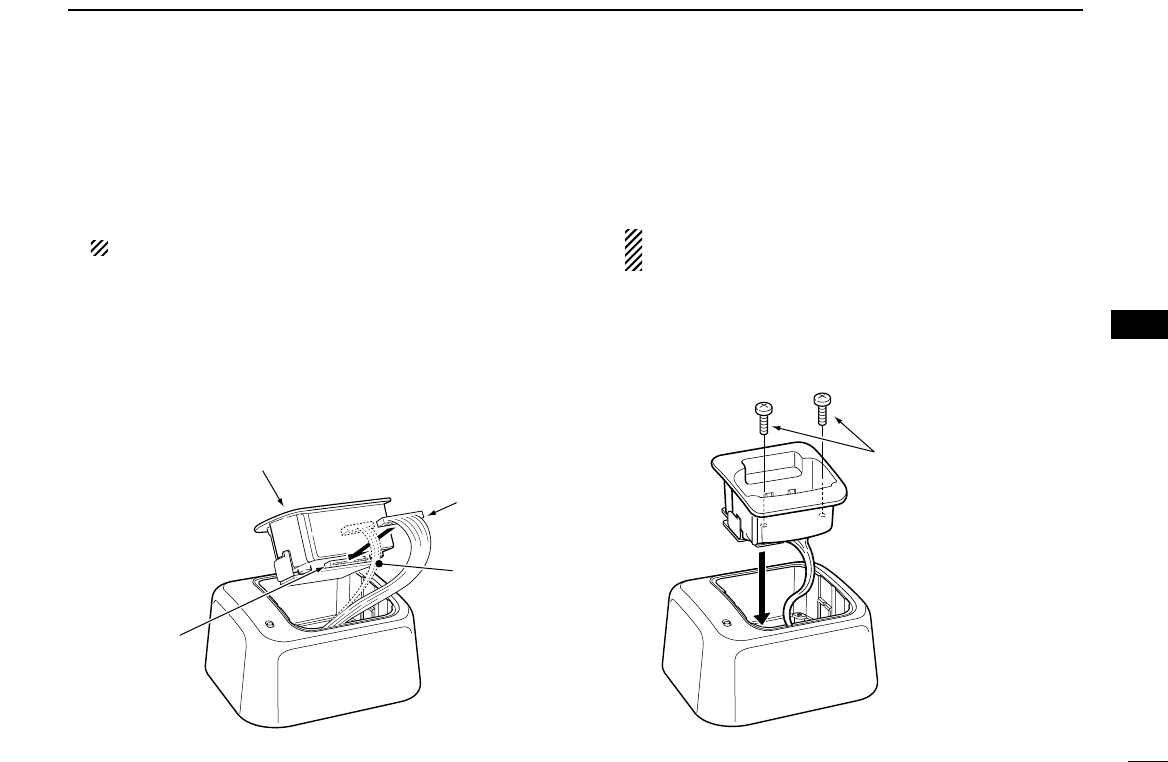
27
7
BATTERY CHARGING
7
■Optional battery chargers
ïAD-109 installation
qConnect the charger’s 10-pins connector to the AD-109
desktop charger adapter’s plug.
NOTE: The 3-pins connector is not used.
wInstall the adapter into the charger in the direction of the
arrow, then use the supplied 2 screws to attach the
charger adapter to the charger.
NOTE: BE CAREFUL not to catch the unused 3-pins
plug between the charger and the charger adapter.
Supplied screws
Desktop charger adapter
10-pins connector
Plug
Not used
(3-pins connector)
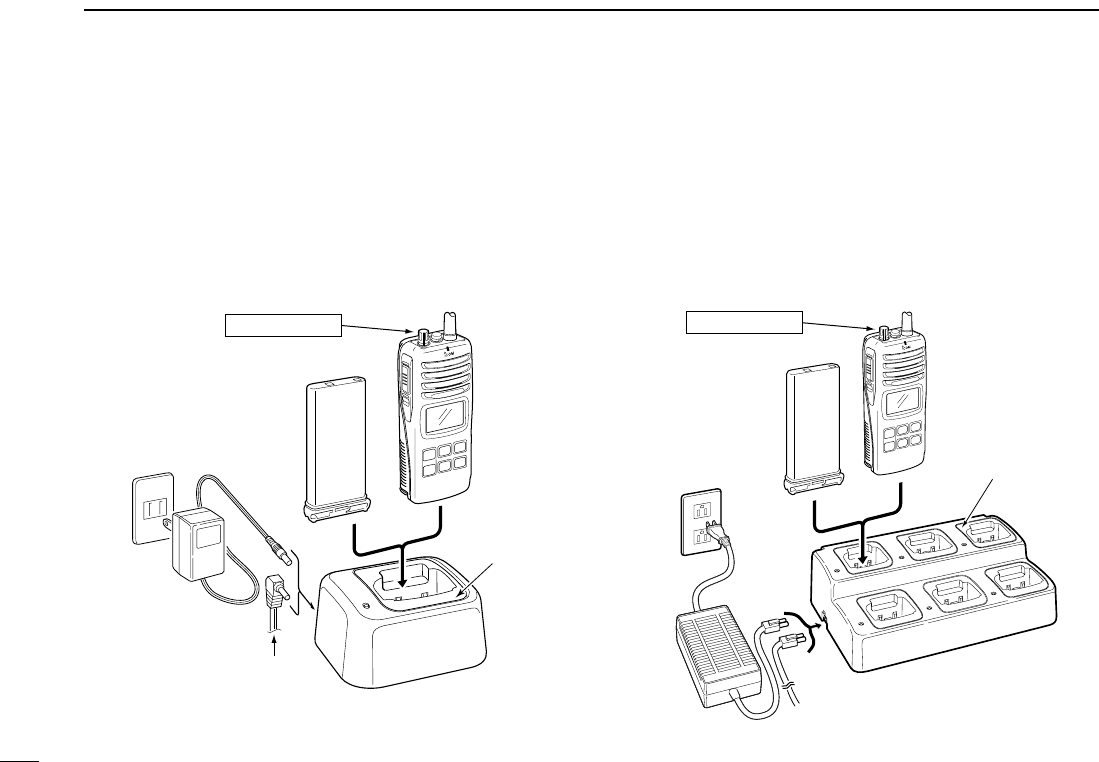
28
7BATTERY CHARGING
ïRapid charging with the BC-119N+AD-109
The optional BC-119N provides rapid charging of battery
packs. The following are additionally required.
• AD-109 charger adapter
• An AC adapter (BC-145A) or the DC power cable (OPC-
515L/CP-17L).
ïRapid charging with the BC-121N+AD-109
The optional BC-121N allows up to 6 battery packs to be
charged simultaneously. The following are additionally re-
quired.
• Six AD-109 charger adapters
• An AC adapter (BC-124) or the DC power cable (OPC-656)
AD-109 charger
adapters are installed
in each slot.
IC-GM1600
BP-224
DC power cable (OPC-656)
(Connect with the DC power supply;
13.8 V/at least 7 A)
AC adapter
(Purchase
separately)
MIC
/SP
Turn power OFF
AD-109 charger
adapter is installed
in BC-119N.
AC adapter
(Not supplied with
some versions.)
Optional OPC-515L (for 13.8 V power
source) or CP-17L (for 12 V cigarette
lighter socket) can be used instead of
the AC adapter.
IC-GM1600
BP-224
MIC
/SP
Turn power OFF
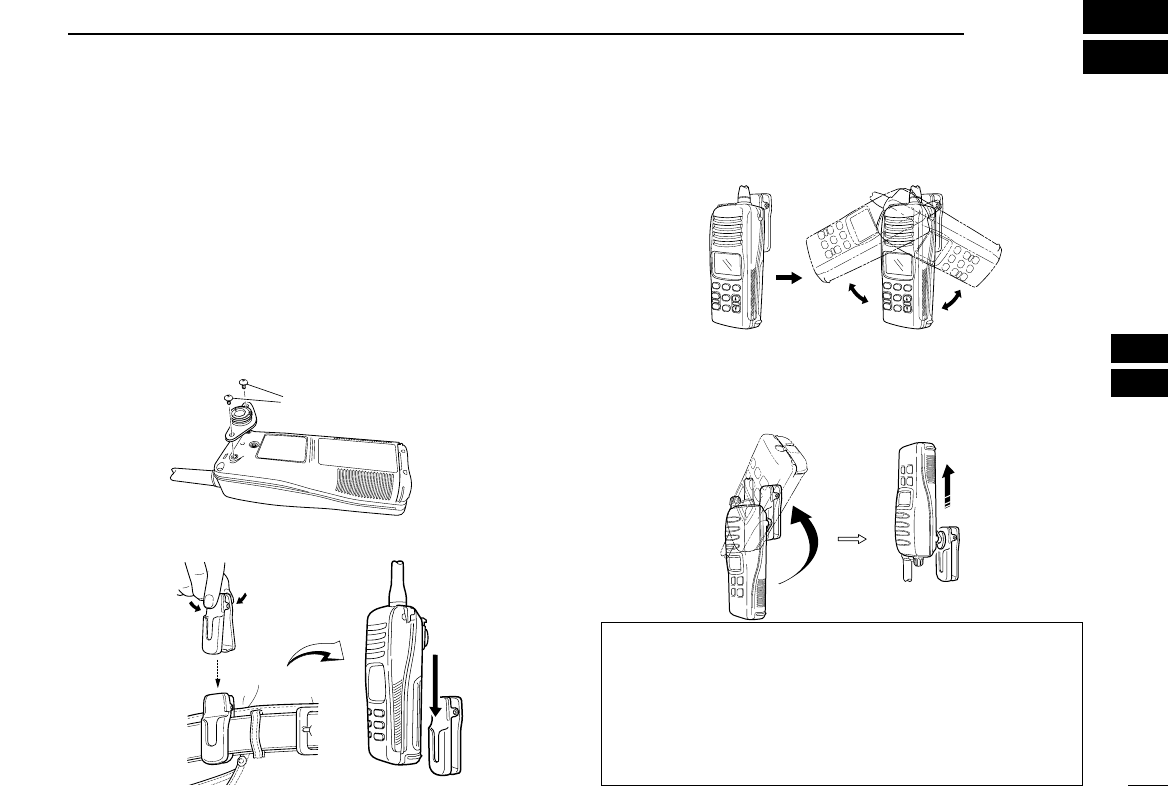
29
8
OPTIONAL SWIVEL BELT CLIP
7
8
■MB-86 contents
Qty.
Belt clip ………………………………………………………… 1
Base clip ……………………………………………………… 1
Supplied screws ……………………………………………… 2
■Attachment
qScrew the base clip to the back of the transceiver using
the two screws (supplied) as shown below.
wClip the belt clip over your belt and insert the transceiver.
eOnce the transceiver is locked in place, it swivels as illus-
trated below.
■Detachment
➥Turn the transceiver upside down in the direction of the
arrow and pull out from the belt clip.
Supplied screws
RRCAUTION!
HOLD THE TRANSCEIVER TIGHTLY, WHEN HANGING
OR DETACHING THE TRANSCEIVER FROM THE BELT
CLIP.
Otherwise the transceiver may not be attached to the belt
clip or swivelled properly if the transceiver is accidentally
dropped and the base clip is scratched or damaged.
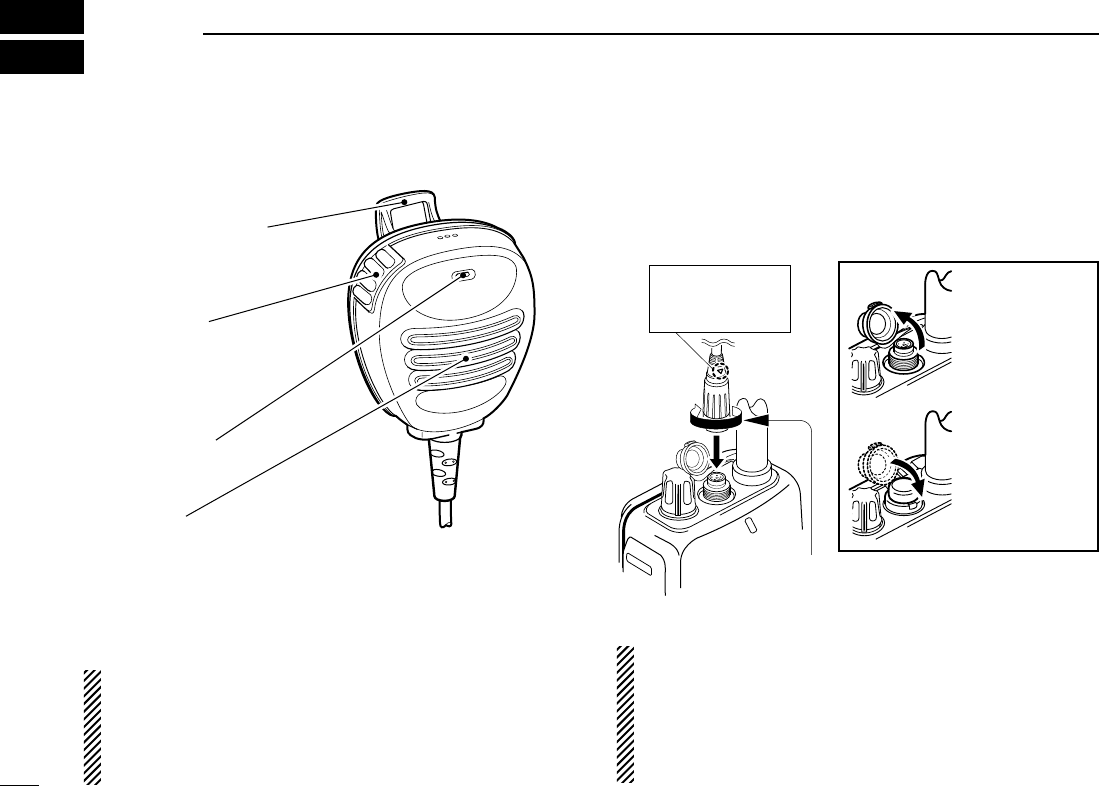
30
OPTIONAL SPEAKER-MICROPHONE
9
■HM-125 descriptions
NEVER immerse the connector in water. If the connector be-
comes wet, be sure to dry BEFORE attaching it to the trans-
ceiver.
NOTE: The microphone is located at the top of the
speaker-microphone, as shown in the diagram above. To
maximize the readability of your transmitted signal (voice),
hold the microphone approx. 2.5 cm (1 inch) from your
mouth, and speak in a normal voice level.
■Attachment
Insert the speaker-mic connector on to [SP MIC] connector
and carefully screw it tight, as shown in the diagram below.
Be careful not to cross thread the connection.
IMPORTANT: KEEP the transceiver’s [SP MIC] connector
cap attached when the speaker-microphone is not in use.
Water will not get into the transceiver even if the cover is
not attached, however, the terminals (pins) will become
rusty, or the transceiver will function abnormally if the con-
nector has become wet.
Alligator type clip
To attach the speaker-mic.
to your shirt or collar, etc.
PTT switch
Transmits during push.
Receives during release.
Microphone
Speaker
Set the triangle
mark to the front
side.
CAUTION: Attach the speaker-microphone’s
connector securely to prevent accidental
dropping, or water intrusion in the connector.
Detaching:
Pull up the cap
in the direction
of the arrow to
detach it.
Attaching:
Attach the cap
in the direction
of the arrow
completely.
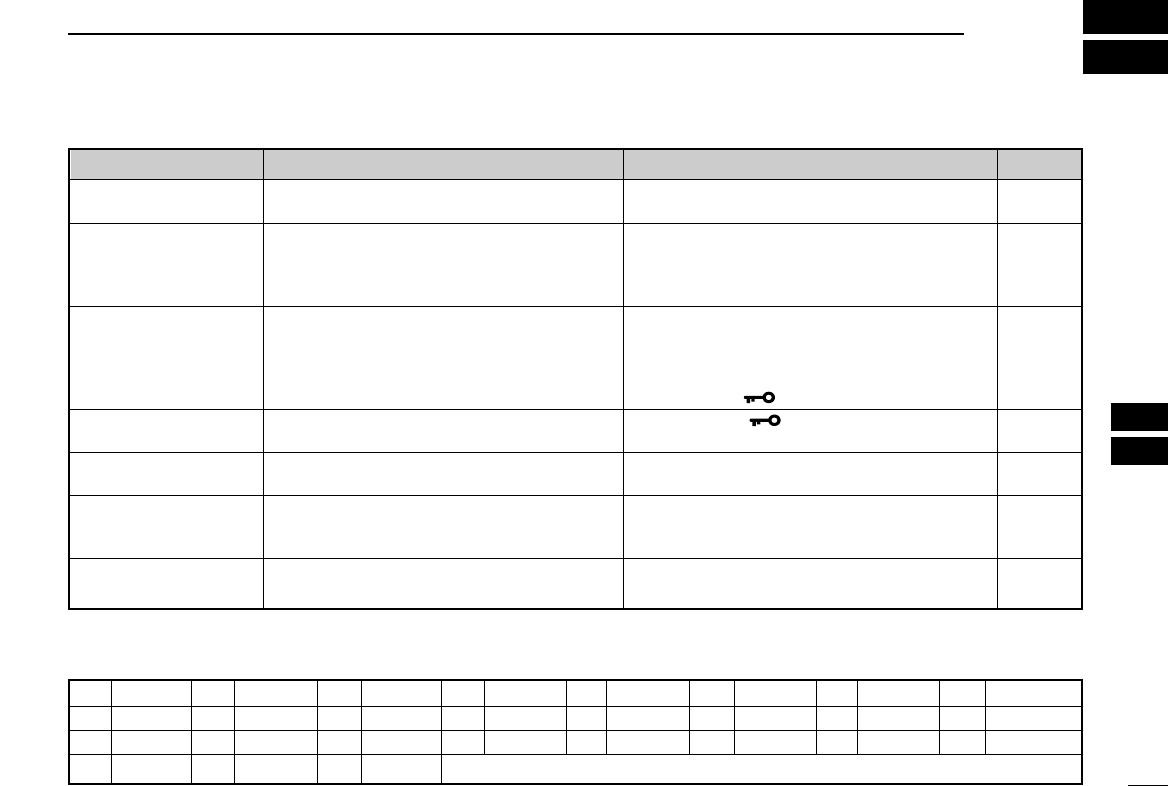
31
10
TROUBLESHOOTING AND SURVIVAL CHANNELS
9
10
The transceiver does
not turn ON.
No sound from the
speaker.
Transmitting is impos-
sible, or high power
can not be selected.
The displayed channel
cannot be changed.
No beeps.
Self check error.
(Temperature)
Self check error.
(Battery voltage)
•The battery is exhausted.
•Bad connection to the battery pack.
•Squelch level is too deep.
•Volume level is too low.
•Speaker has been exposed to water.
• Water has entered to [SP MIC] connector.
•Some channels are for low power or re-
ceive only.
•The battery is exhausted.
•The battery is over charged.
•The output power is set to low.
•Lock function is activated.
•Beep tones are turned OFF.
•The temperature is outside of –35°C to
+80°C; –31°F to +173°F (approx.).
•The connected battery pack’s voltage is
more than 11 V.
•Recharge the battery pack.
•Check the connection to the transceiver.
•Set squelch to the threshold point.
•Rotate [VOL] to set a suitable level.
•Drain water from the speaker.
• Dry [SP MIC] connector.
•Change channels.
•Recharge the battery pack.
•Verify the battery voltage is correct.
•Push [Hi/Lo•] to select high power.
•Push [Hi/Lo•] for 1 sec. to cancel the
function.
•Set the beep tones to ON (Fix Beep/User
Beep) on the SET mode.
•Leave the transceiver at room temperature
for a while. Turn the power ON to check if the
internal temperature has returned to normal.
•Verify the battery voltage is correct.
p. 22
p. 3
p. 9
p. 8
—
—
pgs. 8,
29
p. 22
—
p. 8
p. 10
p. 12
—
—
PROBLEM POSSIBLE CAUSE SOLUTION REF.
• TROUBLESHOOTING
• SURVIVAL CHANNELS
CH TX/RX CH TX/RX CH TX/RX CH TX/RX CH TX/RX CH TX/RX CH TX/RX CH TX/RX
06 156.300 08 156.400 09 156.450 10 156.500 11 156.550 12 156.600 13 156.650 14 156.700
15* 156.750 16 156.800 17* 156.850 67 156.375 68 156.425 69 156.475 71 156.575 72 156.625
73 156.675 74 156.725 77 156.875 *Low power only
Unit: MHz

32
SPECIFICATIONS
11
GENERAL
• Frequency coverage
TX/RX : 156.300–156.875 MHz
• Mode : 16K0G3E
• Channel spacing : 25 kHz
• Power supply requirement : BP-234 or BP-224
• Current drain (at 7.5 V DC) : TX High (2 W) 1.0 A typical
Max. audio 200 mA typical
Power save 20 mA typical
• Useable temperature range : –20°C to +60°C; –4°F to +140°F
• Frequency stability : ±5 ppm
(–20°C to +60°C;
–22°F to +140°F)
• Antenna impedance : 50 Ω
• Dimensions : 65(W) ×145(H) ×44(D) mm
(Projections not included) 29⁄16(W) ×523⁄32(H) ×13⁄4(D) inch
• Weight (with BP-224) : Approx. 385 g (13.6 oz)
TRANSMITTER
• Output power (at 7.5 V DC) : 2 W (Hi) and 1 W (Low)
• Modulation system : Variable reactance frequency
modulation
• Microphone impedance : 2 kΩ
• Max. frequency deviation : ±5 kHz
• Adjacent channel power : 70 dB
• Spurious emissions : Less than –70 dBc typical
RECEIVER
• Receive system : Double-conversion
superheterodyne
• Sensitivity (12 dB SINAD) : 0.25 µV typical
• Squelch sensitivity : Less than 0.35 µV typical
(at threshold)
• Intermodulation rejection ratio : 70 dB typical
• Spurious response rejection ratio : 70 dB typical
• Adjacent channel selectivity : 70 dB typical
• Audio output power : 0.35 W typical at 10% distor-
tion with an 8 Ωload
All stated specifications are subject to change without notice or
obligation.

33
12
OPTIONS
11
12
DBATTERY CASE AND PACK
•BP-224 Ni-Cd
BATTERY PACK
7.2 V/750 mAh Ni-Cd battery pack.
•BP-225 Ni-Cd
BATTERY PACK
7.2 V/1100 mAh Ni-Cd battery pack.
•BP-234
LITHIUM BATTERY PACK
9.0 V 3300 mA Lithium battery pack.
DCHARGERS
•BC-119N
DESKTOP CHARGER
+ AD-109
CHARGER ADAPTER
+ BC-145A
AC ADAPTER
For rapid charging of battery packs. An AC adapter is supplied with
the charger depending on versions. Charging time: approx. 1.5 to 2
hours (BP-224).
•BC-121N
MULTI
-
CHARGER
+ AD-109
CHARGER ADAPTER
(6 pcs.)
+ BC-124
AC ADAPTER
For rapid charging of up to 6 battery packs (six AD-109’s are re-
quired) simultaneously. An AC adapter should be purchased sepa-
rately. Charging time: approx. 1.5 to 2 hours (BP-224).
•BC-158
DESKTOP CHARGER
+ BC-147A
AC ADAPTER
Used for regular charging of battery pack. The same as supplied
with the transceiver. Charging time: approx. 8 hours (BP-224).
DBELT CLIPS
•MB-103Y
BELT CLIP
The same as supplied with the transceiver.
•MB-86
SWIVEL BELT CLIP
Belt clip for swivel type.
•MB-96F/96N
BELT HANGER
➥MB-96F: Attaches with the supplied belt clip (Not swivel type).
➥MB-96N: Belt hanger for swivel type.
DDC CABLES
•CP-17L
CIGARETTE LIGHTER CABLE
Charges the battery pack through a 12 V cigarette lighter socket.
(For BC-119N)
•OPC-515L/OPC-656
DC POWER CABLES
Charges the battery pack using 13.8 V power source instead of the
AC adapter.
OPC-515L: For BC-119N
OPC-656 : For BC-121N
DOTHER OPTIONS
•HM-125
SPEAKER
-
MICROPHONE
Full sized waterproof (JIS grade 7; 1m/30 min.) speaker-micro-
phone. Includes an alligator clip to attach the speaker mic to your
shirt or collar, etc.
•HS-94/HS-95/HS-97
HEADSET
+ OPC-1392
HEADSET ADAPTER
HS-94: Ear-piece type
HS-95: Neck-arm type
HS-97: Throat microphone
Different versions of this radio use different options. Ask
your authorized dealers for details.
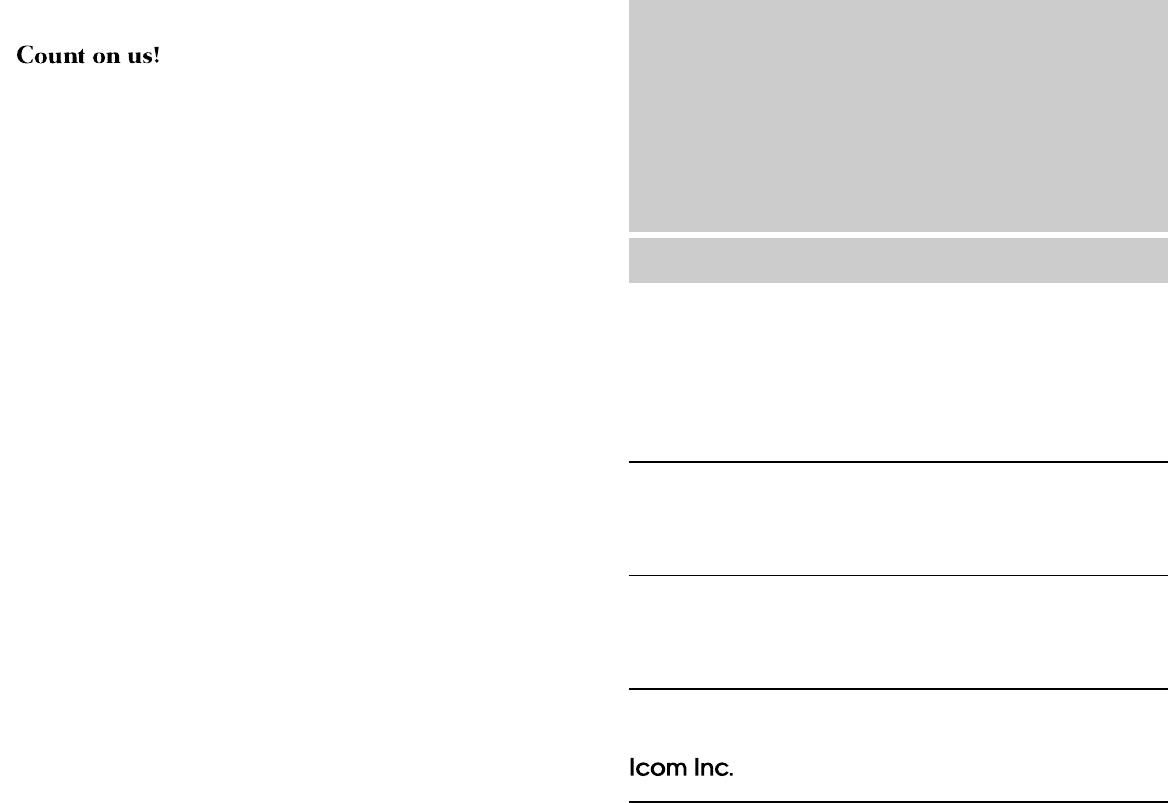
1-1-32 Kamiminami, Hirano-ku, Osaka 547-0003, Japan
A-6383H-1EX
Printed in Japan
©2004 Icom Inc.